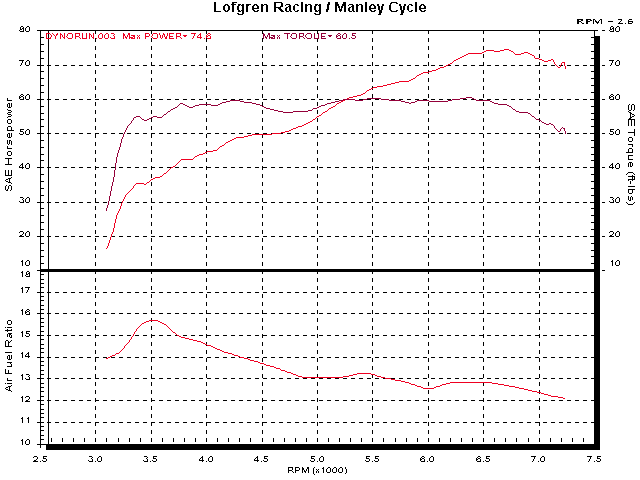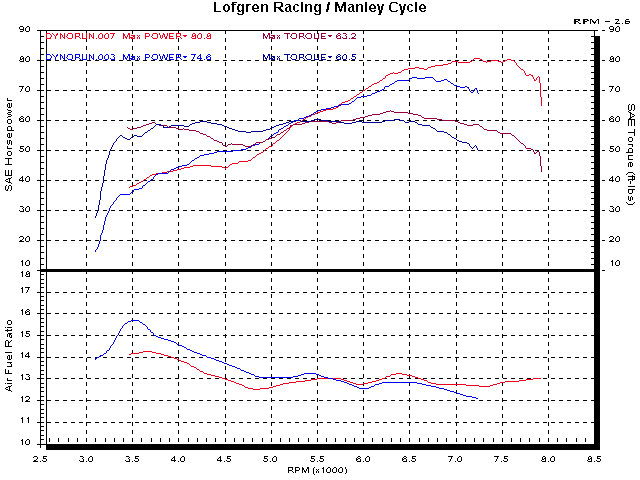
Moto Guzzi Sport 1100 Investigation
Between idle and the rev limiter there are an infinite number of throttle/RPM points. The 1.6M Weber-Marelli ECU only uses 256 of them. Done properly, that is enough to deliver good performance and drivability.
The subject bike of this 'exercise in futility' has been owned by a very loyal Guzzisti. But even the most loyal can waiver. Apparently, the bike has had it's drivability issues for its entire life.
The bike has a WPC12 chip, supplied by Will Creedon. The idle performance is like stock, and the WOT fuel is OK for the exhaust combination on the bike. (More about that later.) The 'Will' chip has been pretty good but the bike still had drivability issues.
Drivability;
After starting with the basic by-the-book physical set-up of the throttle plates and the TPS, I'm not surprised that there were some 'issues'.
The TPS voltage was 34mV at idle. The proper value is 150mV closed and 378mV at idle. That means that the ECU has to wait for the throttles to move almost 4 degrees until it changes values from the bottom line on the fuel or ignition maps.
This points out the importance of going through the tedious set-up process every time mapping is done or there is a question of drivability. That is the reference for the entire map.
All of the TPS tweaking and the other hocus-pocus is about fooling the computer (ideally) into thinking the throttles are open and it needs more fuel. When we are mapping we don't need to fool the ECU, we just put in the right amount of fuel (and ignition timing.)
Maximum Power;
Having the precise air/fuel ratio isn't necessary to make most of the power that the engine is capable of producing. (Don't misunderstand my position on this, whether it shows up on short dyno runs or not, getting an appropriate air/fuel ratio at WOT is an important part of this 'mapping' process.)
Fuel injection subjects the fuel to a high pressure drop (usually 3 Bar or 42 PSI) which does a lot to atomize the fuel. A carburator operates at a couple inches of water pressure drop. That is less than 1/200th of the pressure of an injection system.
With an injection system, for some reason, engines seem more tolerant of variations from best power mixture, especially on the lean side. Possibly because the fuel is atomized so well. This is only an empirical conclusion, and not backed by any scientific information.
What this does when I'm mapping an engine is, it can make it difficult to improve on the max HP, over the earliest runs, even when the air/fuel ratio requires some work.
In the case of this Sport 1100, the WOT air/fuel ratio (bottom part of the chart) goes from lean to rich, but it is ideal at the power peak.

As with the V11 Sports I've done in the past month, the power peaked a little low, in this case 6700 RPM. Since this is still the same 7500+ RPM engine I thought that maybe the stock exhaust cross-over/resonator-muffler would tune a little higher than the after-market one on the bike. I called the customer and requested he bring the stock muffler over for testing.
If the stock muffler has similar results to that of the V11 Sport (Moto Guzzi V11 Sport), it should have a torque dip around 4500 RPM and the power should increase above 6500 RPM. The result on the air/fuel curve should be to flatten it. I decided not to change the WOT fuel until I tested the stock muffler.
Surprise! The red trace is the last run with the stock muffler.

From 4500 RPM to the top of the power curve the air/fuel curve is essentially flat in an ideal range. I talked to Will and he said the basis for this map is a Termignoni kit chip. I have to assume that the factory, again, chose to sacrifice a little torque at 4500 RPM for the extra 6 at the top, and the fuel map confirms that.
I'm sure that someone will toss in the 'smoother torque curve' excuse, but you can't look for power at 60% of your redline.